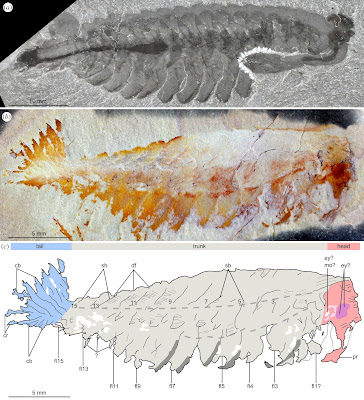 |
| Utaurora comosa Pates, Wolfe, Lerosey-Aubril, Daley & Ortega-Hernández, 2022 |
Abstract
Once considered ‘weird wonders’ of the Cambrian, the emblematic Burgess Shale animals Anomalocaris and Opabinia are now recognized as lower stem-group euarthropods and have provided crucial data for constraining the polarity of key morphological characters in the group. Anomalocaris and its relatives (radiodonts) had worldwide distribution and survived until at least the Devonian. However, despite intense study, Opabinia remains the only formally described opabiniid to date. Here we reinterpret a fossil from the Wheeler Formation of Utah as a new opabiniid, Utaurora comosa nov. gen. et sp. By visualizing the sample of phylogenetic topologies in treespace, our results fortify support for the position of U. comosa beyond the nodal support traditionally applied. Our phylogenetic evidence expands opabiniids to multiple Cambrian stages. Our results underscore the power of treespace visualization for resolving imperfectly preserved fossils and expanding the known diversity and spatio-temporal ranges within the euarthropod lower stem group.
Keywords: Opabiniidae, tree, space, Euarthropoda, Cambrian, phylogenetics, Wheeler Formation
 |
| Utaurora comosa, gen. et sp. nov., from the Wheeler Formation (Cambrian: Drumian), House Range, Utah, USA. |
Systematic palaeontology
Superphylum PANARTHROPODA Nielsen, 1995
Family OPABINIIDAE Walcott, 1912
Diagnosis. Panarthropod with a short head region bearing a single unjointed appendage (proboscis); slender trunk with dorsally transverse furrows delimiting segments; one pair of lateral flaps per body segment; setal blades cover at least part of anterior margin of lateral flaps; caudal fan composed of multiple pairs of caudal blades; pair of short caudal rami with serrated adaxial margins.
Type genus. Opabinia Walcott, 1912
Constituent taxa. Utaurora comosa nov., Opabinia regalis Walcott
Utaurora nov.
Etymology. Concatenation of ‘Utah', where the specimen was collected, and ‘Aurora', Roman goddess of the dawn who turned her lover into a cicada, reflecting the affinities of this taxon as an early stem group euarthropod.
Type material, locality, and horizon. KUMIP 314087, part only, a complete specimen preserved compressed dorso-laterally. Collected by P. Reese from strata of the upper Wheeler Formation (Miaolingian: Drumian), at the Carpoid Quarry (GPS: 39.290417, −113.278519), southwest Antelope Mountain, House Range, Utah, USA.
Diagnosis. Opabiniid with slender trunk composed of at least 13, likely 15, segments (15 in Opabinia); setal structures form blocks that cover the whole width of the trunk and proximal part of the anterior margin of the lateral flaps (setal blades only on flaps in Opabinia); tail fan composed of at least seven pairs of elongate and acuminate caudal blades (three pairs in Opabinia).
Utaurora comosa gen. et sp. nov.
Etymology. ‘Comosa’ (Latin = ‘hairy', ‘leafy') reflects the ‘hairy’ appearance of the dorsal surface, and caudal fan composed of many ‘leaves’.
Stephen Pates, Joanna M. Wolfe, Rudy Lerosey-Aubril, Allison C. Daley and Javier Ortega-Hernández. 2022. New Opabiniid Diversifies the Weirdest Wonders of the Euarthropod Stem Group. Proceedings of the Royal Society B: Biological Sciences. DOI: 10.1098/rspb.2021.2093


